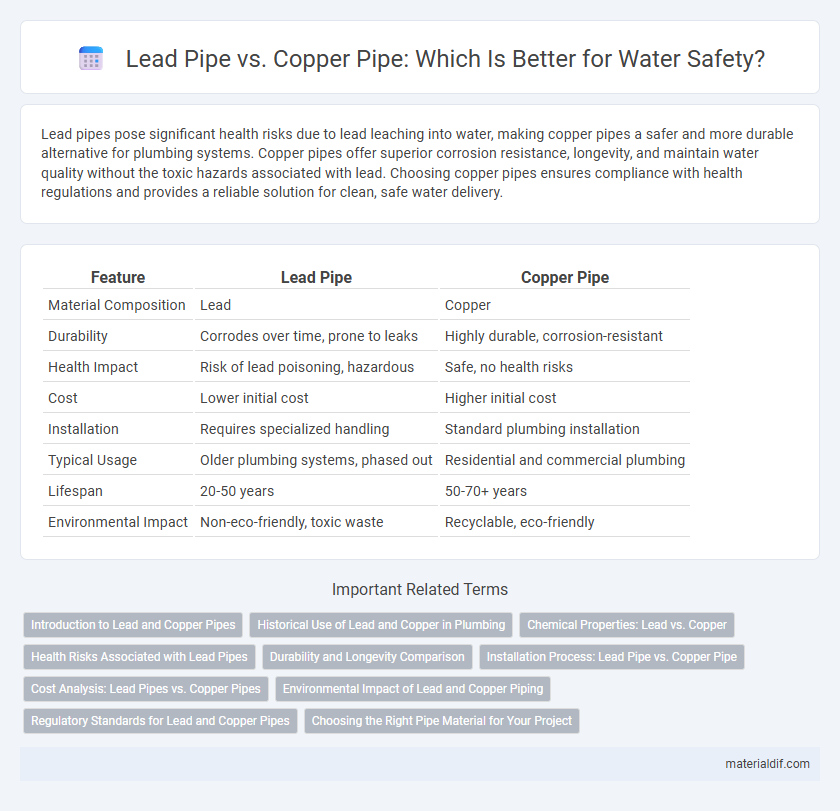Lead pipes pose significant health risks due to lead leaching into water, making copper pipes a safer and more durable alternative for plumbing systems. Copper pipes offer superior corrosion resistance, longevity, and maintain water quality without the toxic hazards associated with lead. Choosing copper pipes ensures compliance with health regulations and provides a reliable solution for clean, safe water delivery.
Table of Comparison
| Feature | Lead Pipe | Copper Pipe |
|---|---|---|
| Material Composition | Lead | Copper |
| Durability | Corrodes over time, prone to leaks | Highly durable, corrosion-resistant |
| Health Impact | Risk of lead poisoning, hazardous | Safe, no health risks |
| Cost | Lower initial cost | Higher initial cost |
| Installation | Requires specialized handling | Standard plumbing installation |
| Typical Usage | Older plumbing systems, phased out | Residential and commercial plumbing |
| Lifespan | 20-50 years | 50-70+ years |
| Environmental Impact | Non-eco-friendly, toxic waste | Recyclable, eco-friendly |
Introduction to Lead and Copper Pipes
Lead pipes have been historically used in plumbing due to their malleability and resistance to corrosion, but their potential health risks from lead exposure have led to widespread replacement. Copper pipes offer durability, corrosion resistance, and safety, making them a preferred choice in modern plumbing systems. Understanding the differences in material composition and health impact is crucial when selecting pipes for water supply lines.
Historical Use of Lead and Copper in Plumbing
Lead pipes were commonly used in plumbing systems from ancient Roman times through the early 20th century due to their malleability and resistance to corrosion. Copper pipes gained popularity in the mid-20th century for residential plumbing because of their durability, resistance to bacterial growth, and improved safety compared to lead. Historical plumbing infrastructures often reveal lead as a significant material, but modern regulations have limited its use due to health risks associated with lead leaching into drinking water.
Chemical Properties: Lead vs. Copper
Lead pipes exhibit higher toxicity due to lead's ability to leach into water, posing significant health risks linked to lead poisoning. Copper pipes resist corrosion better and have antimicrobial properties, minimizing biofilm formation and maintaining water quality. Chemically, lead is more reactive in acidic or soft water environments, increasing its solubility, whereas copper forms a protective patina that limits metal release.
Health Risks Associated with Lead Pipes
Lead pipes pose significant health risks due to the potential leaching of lead into drinking water, which can cause neurological damage, especially in children and pregnant women. Copper pipes, while generally safer, can corrode under certain water conditions, releasing copper ions that may cause gastrointestinal distress but do not carry the same chronic toxicity concerns as lead. Regulatory standards strictly limit lead levels in water, emphasizing the importance of replacing lead pipes to prevent lead poisoning and associated health problems.
Durability and Longevity Comparison
Lead pipes exhibit significant corrosion over time, leading to potential leaks and water contamination, making their durability inferior to copper pipes. Copper pipes offer superior longevity, often lasting 50 years or more due to their resistance to corrosion and bacterial growth. The inherent strength and stability of copper pipes make them the preferred choice for long-term plumbing solutions.
Installation Process: Lead Pipe vs. Copper Pipe
The installation process of lead pipes involves heavier, more rigid materials that require specialized tools for cutting and joining, increasing labor complexity and time. Copper pipes offer easier handling and flexibility, allowing quicker installation with standardized fittings such as soldering or compression joints. Copper's corrosion resistance and durability reduce maintenance needs, whereas lead pipes risk contamination and often necessitate replacement rather than repair.
Cost Analysis: Lead Pipes vs. Copper Pipes
Lead pipes typically have a lower initial installation cost compared to copper pipes, but their long-term expenses can be significantly higher due to potential health hazards and increased maintenance requirements. Copper pipes, while more expensive upfront, offer greater durability, corrosion resistance, and lower risk of contamination, which reduces replacement and repair costs over time. Investing in copper piping ultimately provides better cost efficiency and safety in plumbing systems.
Environmental Impact of Lead and Copper Piping
Lead pipes release toxic lead particles into water, posing significant environmental and health risks by contaminating soil and groundwater. Copper pipes, while more environmentally friendly, can still leach trace amounts of copper into water, which in high concentrations may harm aquatic life. Proper disposal and recycling of both lead and copper materials are essential to minimize environmental contamination and promote sustainable piping solutions.
Regulatory Standards for Lead and Copper Pipes
Regulatory standards for lead and copper pipes mandate strict limits on lead content to ensure safe potable water delivery, with the Safe Drinking Water Act (SDWA) enforcing maximum contaminant levels (MCLs) for lead at 15 parts per billion (ppb) and promoting the use of lead-free materials. Copper pipes comply with NSF/ANSI Standard 61, certifying material safety for drinking water systems, while lead pipes are largely banned due to their corrosion risks and potential to leach toxic lead into water supplies. Water utilities must follow the Lead and Copper Rule (LCR), which requires corrosion control treatments and regular monitoring to minimize lead exposure from plumbing materials.
Choosing the Right Pipe Material for Your Project
When choosing the right pipe material for your project, consider lead pipes due to their durability but recognize their health risks from lead contamination. Copper pipes offer superior corrosion resistance and are safer for drinking water systems, making them a preferred choice in modern plumbing. Evaluating factors like cost, longevity, and water quality impact ensures the optimal pipe selection.
Lead Pipe vs Copper Pipe Infographic

 materialdif.com
materialdif.com